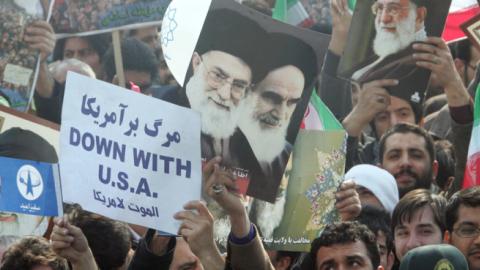Israel and Hezbollah, the Lebanese-based militant organization, have tacitly upheld a tense truce since 2006. Israel has refrained from significant strikes in Lebanon; Hezbollah has decreased its harassment on the Israel-Lebanon border and not initiated rocket barrages against Israel.
Any renewed conflict carries risks for both.
Even with Israel’s anti-missile Iron Dome negating the economic damage of a confrontation, a large-scale ground campaign would exact a price in blood. In 2014, Prime Minister Benjamin Netanyahu's fear of public backlash against high casualties influenced tactical and operational choices in Gaza. Today, similar anxieties are certain to apply.
Hezbollah, on the other hand, has emerged victorious but bloodied from eight years of civil war in Syria. It recruited fighters in southern Syria, constructed new missile factories and received fresh supplies, but an immediate war still would be costly. Moreover, Israel’s Iron Dome modifies the strategic balance.
Nevertheless, war will come — if not now, then soon. Hezbollah’s bloody pact with Iran demands it. Indeed, one must look east to find the real source of tension on Israel’s northern border.
The Iranian regime blends Persian imperial haughtiness with Shia supremacism. Like Cyrus the Great, the first Persian emperor who held the title of “King of the Four Corners of the Earth,” Tehran’s theocrats intend to seize leadership of today’s Islamic world.
But Iran’s quest for Near Eastern and Islamic primacy requires accomplishing multiple objectives. It must defeat the Saudi-aligned Gulf monarchies, undermine the Hashemites in Jordan, and confront or co-opt a similarly neo-imperial Turkey, all while avoiding a fall from Russia’s good graces.
America and Israel, the “Great” and “Little” Satans, are Iran’s greatest adversaries. Understanding the threat each poses requires examining Iran’s gains over three decades.
Iran spent the 1990s expanding its nuclear infrastructure. It turned post-2003 Iraqi factionalism to its advantage, sponsoring Shia militias that killed American soldiers; when the Iraqi army dissolved during ISIS’s June 2014 offensive, those militias became integral to Iraq’s survival. Iran has now infected Iraq’s political and military infrastructure, with the Shia militias becoming Iraq’s version of Iran’s Republican Guard.
Iran also has transformed Syria from a strategic ally to a virtual proxy; Syrian President Bashar al-Assad owes his life to Hezbollah and to the Quds Force, Iran’s special operations forces. Russian airpower decisively tipped the scales in Assad’s favor, but Iranian intervention during the first four years of war ensured his survival.
Iran has now created a land corridor from Kermanshah to Latakia and Beirut, linking Tehran to the eastern Mediterranean. It is no coincidence that Iran solidified these gains between 2015 and 2017, when the JCPOA nuclear deal gave it greater economic and political flexibility. Today, Iran pairs its overland highway to the Levantine Basin with its Yemenite foothold, provided by Houthi insurgents. All the while, its nuclear program remains untouched, and ballistic missile development continues apace.
Iran’s most recent attack on Saudi oil production demonstrates the sophistication and extent of Iranian capabilities. Iran used Ababil 2 drones and Quds-1 cruise missiles to execute the attack. Neither weapon has the needed precision when controlled from a distance, so it is likely that Iranian intelligence infiltrated Saudi Arabia and guided the weapons in their terminal phase. This constitutes one of the great U.S. intelligence failures since 9/11 — a U.S. ally’s oil production crippled due to large-scale sabotage by a hostile power.
Strategically, only America and Israel can check Iranian ambitions. The U.S. maintains a network of Middle Eastern and European bases from which it can concentrate ground and air forces against any point in the region; a U.S. aircraft carrier in the Persian Gulf or Eastern Mediterranean greatly complicates Iran’s ability to operate freely in Syria and Iraq, or to close the Strait of Hormuz and pressure U.S. allies in Asia. Moreover, U.S. diplomatic, financial and commercial pressure can still strangle the Iranian economy, despite the damage the JCPOA and its aftermath did to the U.S. sanctions regime. Unless Iran can eliminate U.S. presence in the Middle East, its broader campaign will remain constricted.
While American military and economic power consistently shackle Iranian ambitions, Israel’s military capabilities pose the most credible threat to Iran’s strategic gains on the ground. Israel operates the region’s most sophisticated military force. Its fleet of F-15s and F-16s could achieve air parity even with Russian forces, let alone Iran’s.
The Israel Defense Forces (IDF) is known for its operational creativity, so Iran must expect an unpredictable response to every one of its defensive redundancies. Israel couples its conventional capabilities with a world-class intelligence service that has already penetrated Iranian defenses, neutralized Iranian nuclear scientists, obtained sensitive information on its nuclear program and potentially engineered the Stuxnet virus that targeted Iranian centrifuges.
Israel’s probable nuclear capabilities make it the greater strategic threat. Even with weapons of mass destruction, Iran cannot simply blackmail Israel to achieve its goals. Critically, Israel is willing to use these capabilities to counter Iranian expansion; it has conducted airstrikes against Iranian targets in Lebanon, Syria and Iraq — the latter with Russian consent — and used force twice to eliminate hostile nuclear programs. So long as Israel exists, Iranian ambitions cannot be fulfilled.
One must also identify an ideological element to Iran’s strategy. Anti-Semitism is central to Iran’s identity; its founding Khomeinist ideology identified the Jews as blasphemers who defiled the Quran. Iran’s pretension to Islamic leadership rings hollow because Islam’s three holiest cities — Mecca, Medina and Jerusalem — all lie in its enemies’ hands: The Saudis control the first two; Israel, the third.
These facts explain the link between Hezbollah and the nuclear program, the two pillars of Iranian strategy. Iran hopes to use Hezbollah to occupy Israel’s and America’s attention, particularly drawing the former’s resources into prolonged ground wars. Hezbollah, like Iranian-sponsored Hamas, is a threat Israel cannot ignore. By placing Israel on the defensive, Iran gains a free hand to consolidate its control over Syria and Iraq, and to pressure America and its Arab allies.
Most important, it can expand its nuclear infrastructure and perfect its delivery systems. Iran need not sprint for breakout immediately. It would rather cultivate its regional position using irregular capabilities and proxies, while avoiding direct confrontation with the United States and Israel for as long as possible.
The ultimate goal will be a nuclear attack against Israel. Unable to conventionally destroy the Jewish state, Iran can instead obliterate Israel’s coastal population centers. Israel’s subsequent counterattack is unlikely to deter Iran — not, however, because Iran is “irrational.” The Islamic Republic lost 2 percent of its population in the Iran-Iraq War; equivalent losses today would total more than 16 million dead — an amount that would require eliminating Iran’s five largest cities. There are, it seems, situations in which Iran would “think about the unthinkable.”
Given this possibility, Israel and America ought to modify their understanding of Hezbollah: It is not a primary threat but the means to a broader end.
Read in The Hill



















